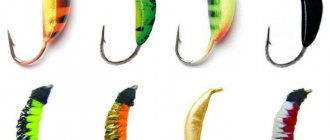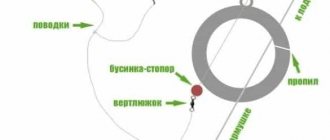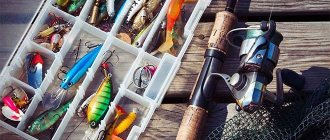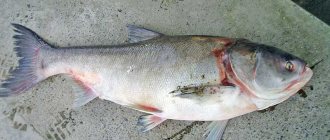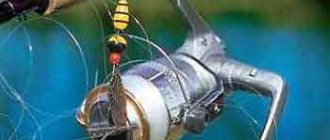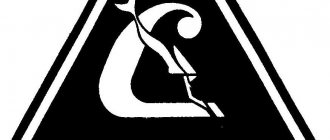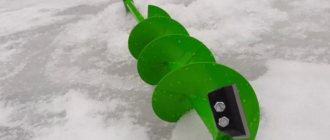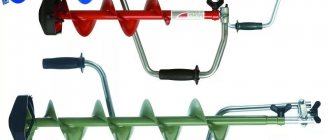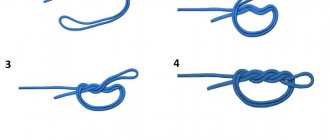Choosing a spinning line becomes a problem for many. Friends advise one thing, the store offers something else, and experienced fishermen claim something completely different. If the variety of lines were smaller, the task would be somewhat simplified, but the gear market is thriving and you have to find a solution yourself.
When choosing a fishing line, first of all, you need to know about its thickness, breaking capacity, material and color. There will be no ideal options, but you can try to choose the most suitable one for yourself.
Line color
In principle, the color of the fishing line has no effect on the size of the catch. The fish, of course, notice the tinted line, but usually everyone uses a clear leader.
However, it is worth noting some nuances:
- If you fish with a spoon in clear water, you can take a neutral gray, camouflage or swamp color.
- On a river with a sandy bottom, use a transparent or sandy one.
- If the pond has a muddy bottom or there is a lot of vegetation, take a green or brown thread.
- When using a jig, it is important to keep an eye on the line, so bright colors are important.
- Yellow braided fish are the most visible in any body of water.
- Dark colors fade in the sun. If you want to control the wiring, they are not easy to see.
- The best control over the bait is achieved with a luminescent fishing line. Pink and white are clearly visible.
Thickness or diameter of fishing line for spinning
This indicator is the main one when choosing a fishing line. It depends on what you will fish with, where and what you are counting on. For small fish, a cord or monofilament of 0.2-0.25 mm is enough. If the reservoir is clean with yellow sand, you can take a smaller diameter.
For light rods - 0.12 - 0.14mm. For inertia-free coils - 0.25–0.27 mm. and for inertial ones - 0.35–0.4 mm.
The thickness also depends on the weights used. Their weight should be compared with the diameter of the fishing line (25 g - 0.27 mm, 37 g - 0.35 mm, 45 g - 0.40 mm).
There is such a thing as a spinning test, which in most cases determines the diameter of the fishing line. For example: test 1.5-12, diameter 0.12-0.16.; test 7-30, diameter 0.25-03.
The thickness of the fishing line plays an important role, but there are many more indicators that require attention. And before you go to the fishing store, study the product thoroughly.
Line diameter
When choosing the diameter of the product, you should remember that the level of catchability, as well as the success of landing large prey, depends on this criterion. Based on these considerations, it is worth taking this process as responsibly as possible and studying the basic rules:
- Decide on the type of fish that will be hunted quietly. If you are going to catch catfish or trophy carp, then experts recommend choosing braids that will meet breaking loads. For example, a diameter of 0.32 mm will do an excellent job of catching a 25 kg trophy. When going to catch crucian carp and small carp, it is enough to purchase a monofilament fishing line with a thickness not exceeding 0.3 mm. Such monofilament is capable of bringing fish weighing about 10 kg ashore. When catching a predator, it is better to use thinner monofilaments (for example, 0.2 mm).
- The second criterion is the fishing location. If the water looks clean and clear, then using a thin diameter will be much more effective. A snagged bottom and an abundance of rocky formations imply the use of denser cords, which will prevent the risk of breakage when fishing.
- The main rule for selecting a leash is a thinner diameter (0.04 mm) than the thickness of the main line. This will ensure the safety of the thread when snagged.
The color scheme is directly dependent on:
- Seasonality of fishing. At any time of the year, transparent types of threads equally successfully cope with their functional purpose. It is advisable to use a green palette of products in the summer months. Brown shades are effectively camouflaged in water in March-April and late autumn.
- The color scheme of the water and the surface of the bottom of the reservoir play an important role when choosing the shade of the fishing line. The presence of a clayey bottom surface should be a significant reason to abandon the greenish palette of products. In muddy water, it is more advisable to purchase a brown palette, which will be successfully camouflaged and will not arouse suspicion among the fish.
monofilament
Monofilament (monofilament) is a well-known, ordinary, solid nylon fishing line, suitable for catching any fish.
When choosing, you should consider:
- Breaking load. It is expressed in kilograms and directly depends on the diameter of the fishing line. For example, a one-kilogram fish can be supported by a 0.12mm monofilament line.
- Strength. Due to its integrity and smoothness, the fishing line is quite wear-resistant and does not fray. Manufacturers offer monofilament with a special coating that improves slip and strength.
- Corresponds to actual dimensions (diameter). Unscrupulous companies have a habit of lying a little about the diameter of the fishing line in the information on the packaging.
- Color. Transparent is better. If you want to experiment, buy two - colorless and colored.
Advantages of monofilament:
- There is not much resistance to water. It is easy to carry the bait near the bottom.
- Resistant to low temperatures. Interaction with water and frost does not affect its structure, except that it makes it less flexible.
- Sufficient rigidity. Good for leash rigs – it doesn’t get tangled.
- Extensibility . When you pull something larger, the tension is distributed partly to the fishing line and partly to the spinning rod, which cannot be said about the cord; here all the responsibility falls on the spinning rod. In other words, monofilament has the ability to dampen fish jerks. For novice fishermen, it erases errors in hooking very well and ensures a smaller catch.
- Invisibility . Unlike the cord, it is practically invisible and does not scare away the fish.
- Not so susceptible to chafing and dishevelment when fishing on stones, snags, and shell rock.
- It glides well in rings and adds casting range when using lures of any weight.
- Availability in terms of price.
Disadvantages of monofilament:
- With small diameters, low breaking load, breaks quickly.
- Not durable, loses its properties when exposed to ultraviolet radiation.
- Its extensibility does more harm than good. When casting long distances (and not only) it is not sensitive to weak bites. Having caught a fish on a monofilament line, you need to “pull” it for a very long time to bring it closer to the shore. Since there is no stretch indicator, not every bait will work.
- Has "memory". The ductility helps the line to fix the position it finds itself in when twisted. When unwinding it falls off in rings.
Which fishing line to choose for pike, perch and light spinning rod
What line to use on a spinning rod for pike fishing? If you use monofilament, its diameter should be equal to or exceed 0.3 mm. If it is intended to catch trophy specimens, then the diameter of the fishing line can be increased within reasonable limits. It is important that the length of the fishing line allows for long casting. A fishing line that is too thick may simply not have enough space on the spool. When using braid, it is enough to use a cord with a thickness of 0.18-0.2 mm. Only a metal product is used as a leash.
For catching perch, braid with a diameter of 0.08-0.12 mm is quite suitable. Thanks to the small diameter of the cord, the bait can be cast far and very accurately. The sensitivity of such gear will be maximum.
Light class spinning rod is considered universal. With its help, various types of predators are caught using a wide variety of baits. Since the weight of baits for such a spinning rod is limited to 3-14 grams, monofilament with a diameter of 0.18-0.25 mm is installed on it. When using a braided cord, its thickness should be in the range of 0.1 - 0.15 mm.
Monoline on a spool
Network
The appearance of the “cord” and “thread” greatly facilitated and diversified the fishing life of spinners.
Braid is a fishing line consisting of small, well-woven synthetic threads, impregnated with a special lubricant and with a sheath (not always). Compared to its monofilament counterpart, it has twice the strength.
Advantages of braid:
- Lack of memory. No matter what you do, whether you tie a knot, wrap it, twist it, or how long it stays in this position, the line will still be straight and even when unwinding. There are indeed models where this quality is not so ideal.
- Strength. With frequent contact with uneven bottoms, the “cord”, unfortunately, frays and loses its impregnation.
- Variety of colors. You can choose an option for a dark bottom, matching the color of algae. If you want to control and see the thread, choose a contrasting shade.
- Sensitivity. Due to lack of extensibility. The most insignificant bite is visible, which can be hooked sharply, reliably and quickly. There is a greater chance that you will catch at least something.
- Not stretchable. Allows you to fish out expensive bait caught on small snags; under pressure, the hook will straighten or break off the obstacle.
- Impregnation. In addition to lubricants that give the fishing line reliability and strength, some companies use flavorings in impregnation that attract fish.
Disadvantages of braid:
- Not stretchable. For hooking and rescuing baits, this is a plus. But, having caught a big trophy, you need to be wary of the spinning rod, especially the thin one. With such a fishing line, fish with torn lips are more often caught.
- Color. There are no transparent cords. Whatever color you choose, the fish sees it and is wary. If in one body of water the braid is less noticeable, then in another it can simply catch the eye.
- Sensitivity to cold. A temperature of -4 °C is already dangerous for the “thread”. The wet fishing line is covered with frost, the lubricant is lost, several such regular freezes and it is practically ruined.
- Absorbs moisture. It is not always possible to unwind and dry the fishing line properly. Often the cord wears out and loses functionality.
- Price. They cost more than monofilament ones, but they need to be replaced.
Prices for fishing lines for spinning
The cheapest fishing line for spinning is monofilament; prices for a spool with 100 meters of such thread start at approximately 70 rubles. But a good monofilament costs much more, and the price of a modern high-quality monofilament line, designed specifically for spinning fishing, reaches 700 or more rubles per 100 meters.
A cheap braided line 135 m long will cost at least 400 rubles. For more expensive brands, this figure reaches 2000 or more rubles. Braid is worth the money and, if used correctly, will last quite a long time, so it fully justifies its price, and you should not save on the purchase of such an important element of spinning tackle as fishing line.
The price of 100 meters of fluorocarbon is about 350-1500 rubles, 150 meters can be bought for 500 rubles or more. Fluorocarbon leader line, which is sold in reels of 20 meters or more, will cost 100 or more rubles per reel.
Fluorocarbon
Fishing line based on chemical polymers. It has been used for a long time, but as a leash material. Thanks to its composition, it is very wear-resistant, practically invulnerable, but expensive and breaks quickly, so it is not used as the main one, but for a leash of 1-3 m it is just right.
The main feature of fluorocarbon is invisibility. Its refractive index of light is almost the same as that of water. The fish practically does not see it.
Advantages of fluorocarbon:
- The most inconspicuous of all fishing lines. Smart fish are sometimes very alarmed by a colored cord.
- Wear resistance. Leska is not afraid of heat, cold, or moisture. It does not wear off or get cut by stones.
- Large diameter fluorocarbon is often beyond the reach of even the teeth of a predator.
- Great rigidity. It doesn’t get tangled, there are no random knots on it.
- Sinks quickly. This is important for fishing in windy weather.
- Zero stretch. Sensitive to bites, allows you to hook fish more clearly.
Disadvantages of fluorocarbon:
- The same rigidity does not allow making a reliable, strong knot; the fishing line constantly slips out.
- To attach fluorocarbon leashes, special units are needed , but they do not provide a full guarantee.
- Very low breaking load. For this reason, it is not used as the main one. Maybe 0.18-0.2mm in size. for light spinning rods.
Types of fishing lines for spinning
Not so long ago, the raw materials for making fishing lines were horsehair, silk and linen threads, and other materials of natural origin. Now the emphasis is on artificially created analogues. Fishermen are offered the following types of fishing line:
1. Monoline. It is a solid single-filament thread made of nylon, monofilament, and various types of polyamide fibers. Monofilament cord has high strength, rigidity and elasticity, but at the same time it is highly stretchable in water, which sometimes interferes with the jig fishing method. Monoline is most suitable for beginners who are just beginning to learn the intricacies of fishing. 2. Braided. High strength, abrasion resistance, and zero elongation of the fishing line are achieved due to the presence of many fibers. Braided cord is available in two versions - coated and uncoated. Disadvantages include the tendency to form knots, visibility in the water and a high risk of cutting yourself on the cord. 3. Fluorocarbon line. When immersed in water it becomes almost invisible, so it is great for leashes. It has minimal memory and rigidity, increased resistance to abrasion and ultraviolet irradiation. Does not change its properties due to temperature changes. But for all its advantages, this type of cord has low tensile strength and requires knowledge of special knots, since ordinary ones “spread” due to their rigidity.
Main line and leader
A leash is a small part of the fishing line that is tied to the main line in case it takes something large, so that the main line does not break. The leash is attached using different knots.
Its breaking load should be no less than 10% -20% of the main one, regardless of the thickness. Basically, fluorocarbon fishing line 0.1–0.15 mm is used for leashes. – it is reliable and inconspicuous. If catfish or large carp are expected, it is better to take 0.35–0.7mm. For sharp pike teeth, soft steel line for leashes is also suitable.
There are:
- Pop-up leashes are made of braided wire. Use on muddy or cluttered bottoms.
- Strong and tough - if there is a lot of algae.
- Combined - fluorocarbon and thread. If the fisherman wanted to experiment.
Which line to choose for spinning for pike?
The most popular cord is 0.16 - 0.20 mm. If you are using it for the first time, it is better to take a cheap one; it will not last long during active fishing.
Then you can decide on more expensive types of braid.
The color should be dark green or brown.
Braid is especially preferable when using jigs and twitching wobblers.
The cord is also good for long casts.
Monoline lags behind in popularity, but there are times when it is indispensable.
When fishing with spinners, spinners, and spinners, the cord is not suitable. The thickness of the line for spinners is especially important. The diameter should be chosen in the range of 0.28 – 0.35 mm. For the girder – 0.4mm.
Some companies indicate on the packaging that this is a fishing line for pike - Pike (pike): DAIWA Samurai - Pike 3.
Which fishing line to choose for spinning for perch?
Depends on the reservoir and the size of the perch living there. Both monofilament and braid are used. Everyone should try these two types and decide. The diameter of the cord can be 0.1, and the diameter of monofilament line is no more than 0.3. The main thing to remember is the breaking load.
Which fishing line to choose for light spinning rod?
Light (light) spinning rod prefers thin fishing lines. Today, fishermen have not yet decided which is better - monofilament or cord; they use both perfectly. Fishing line is used up to 0.2 mm, braid - up to 0.13 mm
The best fishing line for pike
Pike has very sharp teeth, with which it can easily bite through fishing line of any diameter and thickness. In addition, the fish strongly resists when fished, which requires suitable equipment. It is important that the fishing line for pike spinning is of small diameter, but with good tensile strength. Manufacturers produce special lines for pike fishing; you can recognize this line by the abbreviation PIKE on the packaging.
Experienced fishermen most often use braided line for spinning for pike. Such a cord is sensitive during animation, has a relatively small diameter, but has a high breaking load. Due to its elasticity and low memory, it becomes possible to cast light baits over long distances.
Monofilament is also used for “hunting” pike, but this type of fishing line is highly stretchable, which sometimes creates inconvenience when landing fish. In addition, nylon is less durable compared to other types of cord materials. Fluorocarbon fishing lines are most often used as a leader material; a cord with a diameter of 0.4-0.5 does not lend itself well to the teeth of a predator.
The best manufacturers
Each has its own best manufacturers, it all depends on the wallet and preferences of the fisherman. But the sales leaders are worth noting. Power Pro, Salmo Elite Braid - affordable, reliable fishing lines.
In more detail:
- Mono lines: Browning Cenex Feeda line, Salmo Specialist Feeder, Shimano Technium Spinning, ) Reflo Power Max. Braids: Fire Line. TUF Line. PowerPro. Sunline Deep one. Spiderwire. Salmo Elite Braid.
- Fluorocarbon: Sunline FC SWS Small game, Owner Fluorocarbon, YGK Geso X Leader, Sunline New Super FC Sniper.
Every time an angler chooses a fishing line, he expects the best results from it. If unsuccessful, they complain about the manufacturer, bad pond, or weather. The main thing is to know that the success of fishing, first of all, depends on luck and the mood of the fish, and here it is very difficult to guess.
